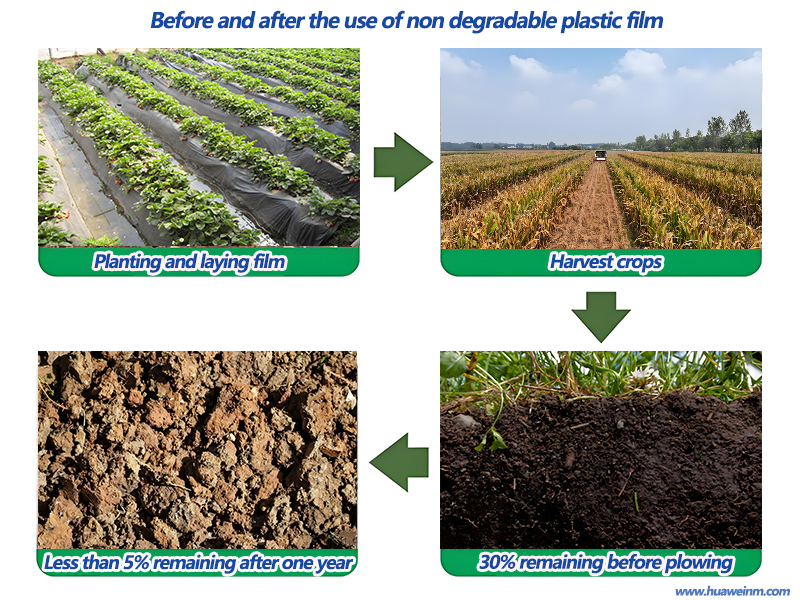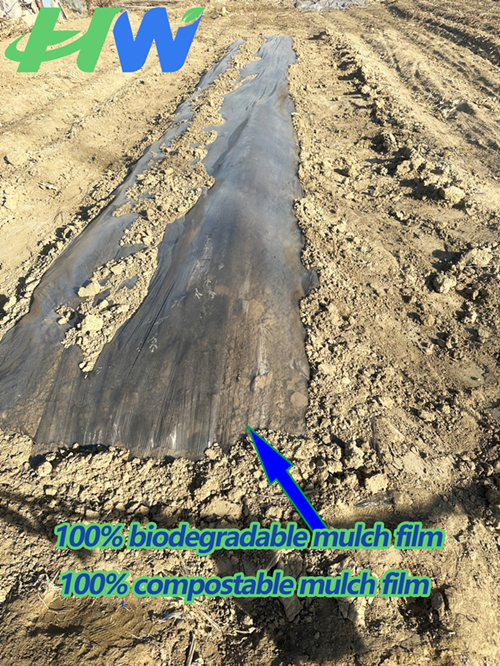1. Degradability
- Biodegradable Mulch Film: Can be broken down by microorganisms, light, moisture, and other natural factors into harmless substances such as carbon dioxide, water, and biomass.
- Non-Biodegradable Mulch Film: Made primarily from polyethylene and other plastics, it does not decompose naturally and remains in the environment for a long time, causing pollution.

2. Environmental Impact
- Biodegradable Mulch Film: Environmentally friendly, as it decomposes into natural substances without leaving harmful residues, reducing long-term environmental pollution.
- Non-Biodegradable Mulch Film: Causes "white pollution" due to its inability to decompose, leading to soil and environmental contamination.
3. Soil Health
- Biodegradable Mulch Film: Improves soil structure by adding organic matter after degradation, enhancing soil fertility and microbial activity.
- Non-Biodegradable Mulch Film: Leaves plastic residues in the soil, leading to soil compaction, reduced fertility, and hindered microbial activity.
4. Degradation Time
- Biodegradable Mulch Film: Degrades within a controllable timeframe, aligning with the crop growth cycle and minimizing post-harvest residue.
- Non-Biodegradable Mulch Film: Does not degrade naturally, accumulating in the soil over time and causing long-term pollution.
5. Chemical Release
- Biodegradable Mulch Film: Typically made from renewable resources like starch or cellulose, it does not release harmful chemicals during degradation.
- Non-Biodegradable Mulch Film: May release harmful chemicals such as plasticizers and stabilizers over time, contaminating the soil and water.
6. Cost and Economic Viability
- Biodegradable Mulch Film: Generally more expensive initially but cost-effective in the long term due to reduced environmental cleanup costs and improved soil health.
- Non-Biodegradable Mulch Film: Cheaper initially but incurs higher long-term costs due to environmental damage and soil remediation needs.
7. Agricultural Benefits
- Biodegradable Mulch Film: Enhances soil moisture retention, temperature regulation, and weed suppression while being eco-friendly.
- Non-Biodegradable Mulch Film: Provides similar agricultural benefits but at the cost of long-term environmental harm and soil degradation.
8. End-of-Life Management
- Biodegradable Mulch Film: Does not require manual removal or disposal, as it decomposes naturally.
- Non-Biodegradable Mulch Film: Requires manual removal and proper disposal, often leading to improper handling and environmental pollution.

A good biodegradable mulch film should possess the following characteristics:
1. Biodegradability
It should be able to decompose into harmless substances such as carbon dioxide, water, and biomass through the action of microorganisms, light, and moisture in the natural environment, thereby reducing long-term pollution.
2. Controlled Degradation Time
The degradation period should align with the crop growth cycle, ensuring protection during the growth phase and rapid degradation after harvest to avoid affecting subsequent farming.
3. Mechanical Properties
It should have sufficient strength, toughness, and elasticity to withstand external forces such as wind, rain, and mechanical operations, ensuring it remains intact during the crop growth period.
4. Thermal and Moisture Retention
It should provide good thermal and moisture retention properties, helping to maintain soil temperature and humidity, and promoting crop growth.
5. Light Transmission
It should have moderate light transmission, meeting the needs of photosynthesis while suppressing weed growth.
6. Environmental Friendliness
The raw materials should come from renewable resources, such as starch and cellulose, and the production process should be low-pollution, with degradation products being environmentally harmless.
7. Cost-Effectiveness
It should be reasonably priced, suitable for large-scale promotion, and offer good value for money.
8. Safety
It should not contain harmful substances, ensuring no adverse effects on soil, crops, or human health.
9. Ease of Use
It should be easy to lay and recover, suitable for mechanized operations, and reduce labor costs.
10. Adaptability
It should be able to adapt to different climates and soil conditions, maintaining stable performance in various environments.
A good biodegradable mulch film should strike a balance between environmental friendliness, functionality, cost-effectiveness, and safety, meeting agricultural needs while minimizing environmental impact.
In summary, biodegradable mulch films are environmentally sustainable, improve soil health, and decompose naturally, while non-biodegradable mulch films cause long-term environmental pollution, harm soil quality, and require costly cleanup efforts.
